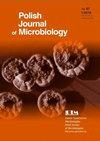斯里兰卡Kadolkele红树林沉积物中生物活性放线菌的鉴定
IF 1.6
4区 生物学
Q4 MICROBIOLOGY
引用次数: 4
摘要
在未知环境中探索未开发的微生物潜力对于发现用于生物技术应用的新型次生代谢物和酶至关重要。在原核生物中,放线菌因产生大量次生代谢物和细胞外酶而被公认。在本研究中,我们利用位于斯里兰卡尼甘布泻湖地区的“Kadolkele”红树林生态系统的表层沉积物分离出具有生物活性的放线菌。在改性淀粉酪蛋白琼脂上分离得到6株放线菌,并对其进行了鉴定。该菌株对四种选定菌株的抑菌活性进行了评估,并产生了细胞外酶:纤维素酶、淀粉酶、蛋白酶和脂肪酶。6株分离物中有3株对金黄色葡萄球菌、大肠杆菌和蜡样芽孢杆菌表现出抗菌活性,但对单核增生李斯特菌没有抗菌活性。5株菌株能产生胞外纤维素酶,6株菌株均表现出淀粉酶活性。6株菌株中只有3株分别对蛋白酶和脂肪酶检测呈阳性。Ac-1、Ac-2和Ac-9经16S rRNA基因测序鉴定为Streptomyces spp.,采用四种不同的溶剂提取色素。丙酮提取的Ac-1和Ac-2粗色素进一步用于孔扩散实验,仅Ac-2粗色素提取物对实验菌的生长有抑制作用。此外,用Ac-1粗色素对六种不同的市售织物进行染色。经过酸、碱和冷水处理后,染色织物仍保持黄色,这表明Ac-1色素在生物技术应用方面具有潜力。本文章由计算机程序翻译,如有差异,请以英文原文为准。
Characterization of Bioactive Actinomycetes Isolated from Kadolkele Mangrove Sediments, Sri Lanka
Abstract Exploring untapped microbial potentials in previously uncharted environments has become crucial in discovering novel secondary metabolites and enzymes for biotechnological applications. Among prokaryotes, actinomycetes are well recognized for producing a vast range of secondary metabolites and extracellular enzymes. In the present study, we have used surface sediments from ‘Kadolkele’ mangrove ecosystem located in the Negombo lagoon area, Sri Lanka, to isolate actinomycetes with bioactive potentials. A total of six actinomycetes were isolated on modified-starch casein agar and characterized. The isolates were evaluated for their antibacterial activity against four selected bacterial strains and to produce extracellular enzymes: cellulase, amylase, protease, and lipase. Three out of the six isolates exhibited antibacterial activity against Staphylococcus aureus, Escherichia coli, and Bacillus cereus, but not against Listeria monocytogenes. Five strains could produce extracellular cellulase, while all six isolates exhibited amylase activity. Only three of the six isolates were positive for protease and lipase assays separately. Ac-1, Ac-2, and Ac-9, identified as Streptomyces spp. with the 16S rRNA gene sequencing, were used for pigment extraction using four different solvents. Acetone-extracted crude pigments of Ac-1 and Ac-2 were further used in well-diffusion assays, and growth inhibition of test bacteria was observed only with the crude pigment extract of Ac-2. Further, six different commercially available fabrics were dyed with crude pigments of Ac-1. The dyed fabrics retained the yellow color after acid, alkaline, and cold-water treatments suggesting the potential of the Ac-1 pigment to be used in biotechnological applications.
求助全文
通过发布文献求助,成功后即可免费获取论文全文。
去求助
来源期刊

Polish Journal of Microbiology
MICROBIOLOGY-
CiteScore
3.70
自引率
4.80%
发文量
41
审稿时长
2 months
期刊介绍:
Polish Journal of Microbiology (PJM) publishes original research articles describing various aspects of basic and applied microbiological research. We are especially interested in articles regarding
- basic biological properties of bacteria and archaea, viruses, and simple
- eukaryotic microorganisms
- genetics and molecular biology
- microbial ecology
- medical bacteriology and public health
- food microbiology
- industrial microbiology
- bacterial biotechnology
 求助内容:
求助内容: 应助结果提醒方式:
应助结果提醒方式:


